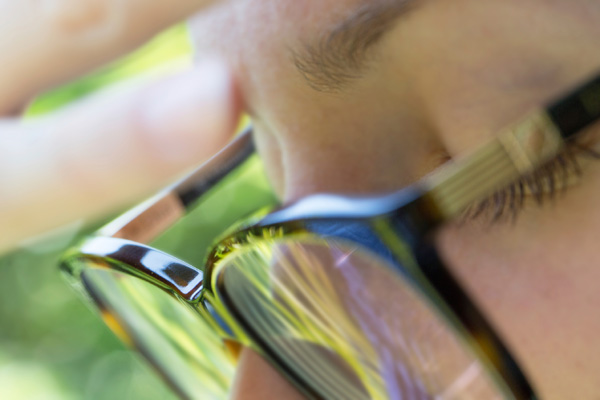
Image: iStock
Light sensitivity, or photophobia, is a frequent symptom of migraine headaches, which affect nearly 15 percent of the world’s population.
Harvard Medical School researchers at Beth Israel Deaconess Medical Center have found that exposing migraine sufferers to a narrow band of green light significantly reduces photophobia and can reduce headache severity.
The study was published May 17 in Brain.
“Although photophobia is not usually as incapacitating as headache pain itself, the inability to endure light can be disabling,” said Rami Burstein, the HMS John Hedley-Whyte Professor of Anaesthesia at Beth Israel Deaconess and lead author of the study.
“More than 80 percent of migraine attacks are associated with and exacerbated by light sensitivity, leading many migraine sufferers to seek the comfort of darkness and isolate themselves from work, family and everyday activities,” said Burstein, who is vice chair of research in the Department of Anesthesia, Critical Care and Pain Medicine and academic director of the Comprehensive Headache Center at Beth Israel Deaconess.
Five years ago, Burstein and colleagues made the surprising discovery that blue light hurts migraine patients who are blind. This finding prompted the idea that abnormal sensitivity to light during migraine could be alleviated by blocking blue light.
Because that earlier study involved only blind patients who could not detect all colors of light, Burstein and his colleagues devised a way to study the effects of different colors of light on headache in patients without visual impairment.
In the current study, Burstein and colleagues found that of all light to which migraine sufferers are exposed, a narrow band of green light worsens migraine significantly less than all other colors of light and that at low intensities green light can even reduce headache pain. Of 69 participants, 41 completed the study.
“These findings offer real hope to patients with migraines and a promising path forward for researchers and clinicians.”—Rami Burstein.
The researchers asked patients experiencing acute migraine attacks to report any change in headache when exposed to different intensities of blue, green, amber and red light.
At high intensity of light—as in a well-lit office—nearly 80 percent of patients reported intensification of headache with exposure to all colors but green. Unexpectedly, the researchers found that green light even reduced pain by about 20 percent.
To understand exactly why green light causes less pain to patients with migraines, Burstein and colleagues designed experiments in which they measured the magnitude of the electrical signals generated by the retina (in the eye) and the cortex (in the brain) of these patients in response to each color of light. They found that blue and red lights generated the largest signals in both the retina and the cortex and that green light generated the smallest signals.
Next, applying techniques recently developed by Rodrigo Noseda, HMS assistant professor of anaesthesia at Beth Israel Deaconess, they used animal models of migraine to study neurons in the thalamus, an area of the brain that transmits information about light from the eye to the cortex. These neurons were found to be most responsive to blue light and least responsive to green light, explaining why the migraine brain responds favorably to green light.
“These findings offer real hope to patients with migraines and a promising path forward for researchers and clinicians,” said Burstein.
Burstein is now working to develop a more affordable light bulb that emits “pure” (narrow-band wavelength) green light at low intensity, as well as affordable sunglasses that block all but this narrow band of pure green light.
Currently, the cost of one such light bulb is prohibitively high, and the technology to block all but pure green light in sunglasses is available only in light microscopy, which is also very costly.
This study was supported by National Institutes of Health grants R37 NS079678 and RO1 NS069847.
Adapted from a Beth Israel Deaconess news release.


